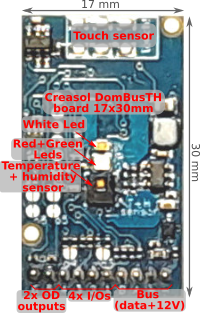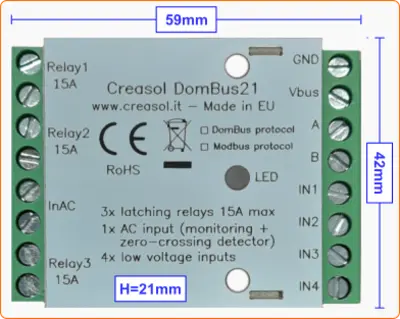
„Creasol DomBusTH“ - „Domoticz“ įrenginys su temperatūros ir drėgmės jutikliais, 4 įėjimais, 2 išėjimais, 3 šviesos diodais
- Išpardavimas!
- −25%
Email: store@creasol.it - Telegram: CreasolTech - Whatsapp: +393283730010
Prioritetinis paštas: greitas ir pigus - Greitasis kurj
Prieš grąžindami prekes susisiekite su mumis!

Labai kompaktiškas ir mažas energijos suvartojimas modulis su 3 relės 15A, 1 kintamosios srovės įėjimas, 4 analoginiai/skaitmeniniai įėjimai.
 Visiškas palaikymas: daugumą produktų sukūrėme mes!
Visiškas palaikymas: daugumą produktų sukūrėme mes!
Email: store@creasol.it - Telegram: CreasolTech - Whatsapp: +393283730010
 Užsakymai išsiunčiami per 1 darbo dieną
Užsakymai išsiunčiami per 1 darbo dieną
Prioritetinis paštas: greitas ir pigus - Greitasis kurj
 24 mėnesių garantija, lengvas grąžinimas / grąžinimas
24 mėnesių garantija, lengvas grąžinimas / grąžinimas
Prieš grąžindami prekes susisiekite su mumis!
Patikimas mažos galios domotic modulis skirtas įjungti / išjungti apkrovas, taupančias energijos sąnaudas, nuliniu budėjimo režimu.
 Tai naudoja 3 fiksavimo relės, 15A 250Vac, kurie nenaudoja nieko, kai yra aktyvūs, ir gali būti naudojami įjungti apkrovas arba generatorius iki 3 kW kurie yra IŠJUNGTI ilgą laiką. Taip pat apkrovų maitinimo atjungimas žaibo metu padeda išvengti elektrostatinių iškrovų žalos.
Tai naudoja 3 fiksavimo relės, 15A 250Vac, kurie nenaudoja nieko, kai yra aktyvūs, ir gali būti naudojami įjungti apkrovas arba generatorius iki 3 kW kurie yra IŠJUNGTI ilgą laiką. Taip pat apkrovų maitinimo atjungimas žaibo metu padeda išvengti elektrostatinių iškrovų žalos.
Jis taip pat turi 1 kintamosios srovės įvestį, skirtą 230 V kintamos srovės įtampai aptikti (aptikti elektros energijos tiekimo nutraukimą), kuri taip pat veikia kaip nulio kirtimo detektorius, leidžiantis įjungti reles, kai įtampa yra nulinė (kad sumažinti įsibėgėjimo srovę, esant talpinėms apkrovoms) ir išjunkite reles, kai srovė lygi nuliui (iki sumažinti viršįtampą esant indukcinėms apkrovoms).
4 žemos įtampos įėjimai, kurį galima konfigūruoti kaip analoginį arba skaitmeninį, leidžia prisijungti mygtukų jungikliai, NTC termozondai, signalizacijos jutikliai ir energijos / dujų / vandens skaitikliai su impulsiniu išėjimu.
3 fiksavimo relės gali būti naudojamos įjungti / išjungti:
Numatytasis adresas: 0xff21
| Prievadas Nr. | Vardas | Pajėgumai | Numatytoji konfigūracija | Aprašymas |
| 1 | RL1 | OUT_DIGITAL | OUT_DIGITAL | SPST 15A fiksavimo relė: ritė aktyvuojama tik įjungimo/išjungimo metu, nieko nenaudoja, kai relė yra ĮJUNGTA arba IŠJUNGTA. INAC įvestis turi būti prijungta prie 230 VAC, kad būtų galima aptikti nulinį kirtimą, išvengiant didelės įjungimo srovės (talpinėms apkrovoms) ir viršįtampių (indukcinėms apkrovoms). |
| 2 | RL2 | OUT_DIGITAL | OUT_DIGITAL | SPST 15A fiksavimo relė: ritė aktyvuojama tik įjungimo/išjungimo metu, nieko nenaudojarelė yra ĮJUNGTA arba IŠJUNGTA. INAC įvestis turi būti prijungta prie 230 VAC, kad būtų galima aptikti nulinį kirtimą, išvengiant didelės įjungimo srovės (talpinėms apkrovoms) ir viršįtampių (indukcinėms apkrovoms). |
| 3 | RL3 | OUT_DIGITAL | OUT_DIGITAL | SPST 15A fiksavimo relė: ritė aktyvuojama tik įjungimo/išjungimo metu, nieko nenaudoja, kai relė yra ĮJUNGTA arba IŠJUNGTA. INAC įvestis turi būti prijungta prie 230 VAC, kad būtų galima aptikti nulinį kirtimą, išvengiant didelės įjungimo srovės (talpinėms apkrovoms) ir viršįtampių (indukcinėms apkrovoms). |
| 4 | INAC | IN_AC, IN_COUNTER | IN_AC | Optoizoliuotas įėjimas, kurį galima prijungti prie grandinės pertraukiklio (pranešti apie elektros energijos tiekimo nutraukimą, ypač šaldytuvams ir šilumos siurbliams), PIR su 230 V išėjimu (stebėti buvimą), šviesą ir prietaisus (stebėti, ar įjungta šviesa ar įrenginiai)./td> |
| 5 | IN1 | IN_DIGITAL, ašN_DIGITAL_PULLDOWN, IN_ANALOG, IN_TWINBUTTON, IN_COUNTER | IN_DIGITAL | Analoginė arba skaitmeninė įvestis su pasirenkamu 10k ištraukimu (pcb trumpiklis) ir pasirenkamu vidiniu ištraukiamu ištraukimu (aktyvuojamas, kai sukonfigūruotas kaip IN_DIGITAL_PULLDOWN). Bendras gnybtų blokas yra GND: mygtukas, jungiklis, dvigubas mygtukas (dvigubas mygtukas su 10k rezistoriumi tarp mygtukų), aliarmo jutiklis, 10k NTC termistorius, skaitiklis su impulsiniu išėjimu (energijos skaitiklis, dujų skaitiklis, vandens srauto matuoklis), ... turi būti prijungtas prie šios įvesties ir į GND. |
| 6 | IN2 | IN_DIGITAL, IN_DIGITAL_PULLDOWN, IN_ANALOG, IN_TWINBUTTON, IN_COUNTER | IN_DIGITAL | Analoginė arba skaitmeninė įvestis su pasirenkamu 10k ištraukimu (pcb trumpiklis) ir pasirenkamu vidiniu ištraukiamu ištraukimu (aktyvuojamas, kai sukonfigūruotas kaip IN_DIGITAL_PULLDOWN). Bendras gnybtų blokas yra GND: mygtukas, jungiklis, dvigubas mygtukas (dvigubas mygtukas su 10k rezistoriumi tarp mygtukų), aliarmo jutiklis, 10k NTC termistorius, skaitiklis su impulsiniu išėjimu (energijos skaitiklis, dujų skaitiklis, vandens srauto matuoklis), ... turi būti prijungtas prie šios įvesties ir į GND. |
| 7 | IN3 | IN_DIGITAL, IN_DIGITAL_PULLDOWN, IN_ANALOG, IN_COUNTER | IN_DIGITAL | Analoginė arba skaitmeninė įvestis su vidiniu ištraukimu arba ištraukiamuoju įėjimu (aktyvuojama, kai sukonfigūruota kaip IN_DIGITAL_PULLDOWN). Bendras gnybtų blokas yra GND: mygtukas, jungiklis, aliarmo jutiklis, skaitiklis su impulsiniu išėjimu (energijos skaitiklis, dujų skaitiklis, vandens srauto matuoklis), ... turi būti prijungtas prie šio įėjimo ir prie GND. |
| 8 | IN4 | IN_DIGITAL, IN_DIGITAL_PULLDOWN, IN_ANALOG, IN_COUNTER | IN_DIGITAL | Analoginė arba skaitmeninė įvestis su vidiniu ištraukimu arba ištraukiamuoju įėjimu (aktyvuojama, kai sukonfigūruota kaip IN_DIGITAL_PULLDOWN). Bendras gnybtų blokas yra GND: mygtukas, jungiklis, aliarmo jutiklis, skaitiklis su impulsiniu išėjimu (energijos skaitiklis, dujų skaitiklis, vandens srauto matuoklis), ... turi būti prijungtas prie šio įėjimo ir prie GND. |
Įjungus modulį, raudoname šviesos diode rodomas dabartinis Modbus pavaldumų adresas (registro adresas = 8192) dešimtainiu formatu, žalias šviesos diodas rodo serijos spartą (reg. 8193), o galiausiai raudoname šviesos diode rodomas nuoseklusis paritetas (reg. 8194). ).
Jei reikšmė lygi nuliui, skleidžiama ilga blykstė.
Pavyzdžiui,jei reg(8192)=33, reg(8193)=0, reg(8194)=0, įjungus maitinimą bus rodomi šie šviesos diodai:
3 raudoni blyksniai, pauzė, 3 raudoni blyksniai (pagalbos adresas = 0x21 = 33 po kablelio), pauzė, 1 ilgas žalias blyksnis (reg (8193) = 0 => baudos greitis = 115200 bps), pauzė, 1 ilgas raudonas blyksnis (reg(8194) =0 => paritetas = Nėra).
Įrenginys veiks tik tada, kai bus rodomi adreso / spartos / pariteto parametrai: tada modulis priims Modbus RTU komandas ir periodiškai rodys visų prievadų išvesties būseną nuo 1 iki maksimalaus prievado: žalia blykstė reiškia, kad prievado būsena yra Išjungta, raudona blykstė reiškia, kad prievadas įjungtas.
Numatytasis pavaldaus adresas: 33 (0x21)
| Adr | Vardas | Vertybės | Aprašymas |
| 0 | RL1 | 0 = IŠJUNGTA, 1 arba 65280 = ĮJUNGTA, 2-65279 = ĮJUNGTA nurodytam laikui. Logika gali būti apversta nurodant parinktį INVERTED (adresu 512 + prievadas) |
SPST 15A fiksavimo relė: ritė aktyvuojama tik įjungimo/išjungimo metu, nieko nenaudoja, kai relė yra ĮJUNGTA arba IŠJUNGTA. INAC įvestis turi būti prijungta prie 230 VAC, kad būtų galima aptikti nulinį kirtimą ir išvengti didelioskubėjimo srovė (talpinėms apkrovoms) ir viršįtampa (indukcinėms apkrovoms) |
| 1 | RL2 | 0 = IŠJUNGTA, 1 arba 65280 = ĮJUNGTA, 2-65279 = ĮJUNGTA nurodytam laikui. Logika gali būti apversta nurodant parinktį INVERTED (adresu 512 + prievadas) |
SPST 15A fiksavimo relė: ritė aktyvuojama tik įjungimo/išjungimo metu, nieko nenaudoja, kai relė yra ĮJUNGTA arba IŠJUNGTA. INAC įvestis turi būti prijungta prie 230 VAC, kad būtų galima aptikti nulinį kirtimą, išvengiant didelės įjungimo srovės (talpinėms apkrovoms) ir viršįtampių (indukcinėms apkrovoms). |
| 2 | RL3 | 0 = IŠJUNGTA, 1 arba 65280 = ĮJUNGTA, 2-65279 = ĮJUNGTA nurodytam laikui. Logika gali būti apversta nurodant parinktį INVERTED (adresu 512 + prievadas) |
SPST 15A fiksavimo relė: ritė aktyvuojama tik įjungimo/išjungimo metu, nieko nenaudoja, kai relė yra ĮJUNGTA arba IŠJUNGTA. INAC įvestis turi būti prijungta prie 230 VAC, kad būtų galima aptikti nulinį kirtimą, išvengiant didelės įjungimo srovės (talpinėms apkrovoms) ir viršįtampių (indukcinėms apkrovoms). |
| 3 | INAC | 0 = IŠJUNGTA (plaukiojanti), 1 = ĮJUNGTA (aptiktas 100–250 V signalas) | Optoizoliuotas įėjimas, kurį galima prijungti prie grandinės pertraukiklio (pranešti apie elektros energijos tiekimo nutraukimą, ypač šaldytuvams ir šilumos siurbliams), PIR su 230 V išėjimu (stebėti buvimą), šviesą ir prietaisus (stebėti, ar įjungta šviesa ar įrenginiai)./td> |
| 4 | IN1 | 0 = IŠJUNGTA, 1 = ĮJUNGTA arba 0-65535, jei prievadas sukonfigūruotas kaip analoginis. Daugiau informacijos rasite toliau. |
Analoginė arba skaitmeninė įvestis su pasirenkamu 10k ištraukimu (pcb trumpiklis) ir pasirenkamu vidiniu ištraukiamu ištraukimu (aktyvuojamas, kai sukonfigūruotas kaip IN_DIGITAL_PULLDOWN). Bendras gnybtų blokas yra GND: mygtukas, jungiklis, dvigubas mygtukas (dvigubas mygtukas su 10k rezistoriumi tarp mygtukų), aliarmo jutiklis, 10k NTC termistorius, skaitiklis su impulsiniu išėjimu (energijos skaitiklis, dujų skaitiklis, vandens srauto matuoklis), ... turi būti prijungtas prie šios įvesties ir į GND. |
| 5 | IN2 | 0 = IŠJUNGTA, 1 = ĮJUNGTA arba 0-65535, jei prievadas sukonfigūruotas kaip analoginis. Daugiau informacijos rasite toliau. |
Analoginis arba skaitmeninis įėjimas su pasirenkamu 10k ištraukimu (pcb trumpiklis)ir pasirenkamas vidinis išskleidžiamasis meniu (aktyvuojamas, kai sukonfigūruotas kaip IN_DIGITAL_PULLDOWN). Bendras gnybtų blokas yra GND: mygtukas, jungiklis, dvigubas mygtukas (dvigubas mygtukas su 10k rezistoriumi tarp mygtukų), aliarmo jutiklis, 10k NTC termistorius, skaitiklis su impulsiniu išėjimu (energijos skaitiklis, dujų skaitiklis, vandens srauto matuoklis), ... prie šios įvesties ir į GND. |
| 6 | IN3 | 0 = IŠJUNGTA, 1 = ĮJUNGTA arba 0-65535, jei prievadas sukonfigūruotas kaip analoginis. Daugiau informacijos rasite toliau. |
Analoginė arba skaitmeninė įvestis su vidiniu ištraukimu arba ištraukiamuoju įėjimu (aktyvuojama, kai sukonfigūruota kaip IN_DIGITAL_PULLDOWN). Bendras gnybtų blokas yra GND: mygtukas, jungiklis, aliarmo jutiklis, skaitiklis su impulsiniu išėjimu (energijos skaitiklis, dujų skaitiklis, vandens srauto matuoklis), ... turi būti prijungtas prie šio įėjimo ir prie GND. |
| 7 | IN4 | 0 = IŠJUNGTA, 1 = ĮJUNGTA arba 0-65535, jei prievadas sukonfigūruotas kaip analoginis. Daugiau informacijos rasite toliau. |
Analoginė arba skaitmeninė įvestis su vidiniu ištraukimu arba ištraukiamuoju įėjimu (aktyvuojama, kai sukonfigūruota kaip IN_DIGITAL_PULLDOWN). Bendras gnybtų blokas yra GND: mygtukas, jungiklis, aliarmo jutiklis, skaitiklis su impulsuišėjimas (energijos skaitiklis, dujų skaitiklis, vandens srauto matuoklis), ... turi būti prijungtas prie šio įėjimo ir prie GND. |
| 256-273 | Prievado konfigūracija | 1=OUT_DIGITAL, 2=OUT_RELAY_LP,... |
Komanda naudojama konfigūruoti 1 prievadą (256), 2 prievadą (257), ... kaip OUT_DIGITAL arba OUT_RELAY_LP (mažo energijos suvartojimo relę) arba kitą reikšmę (žr. lentelę toliau) |
| 512-529 | Uosto parinktis | 0=NORMALUS, 1 = INVERTED (išvestis paprastai ĮJUNGTA arba įvestis yra ĮJUNGTA, kai prievado įtampa yra 0 V) | Nustatykite prievado parinktį. Jei nustatyta 1, išėjimas lieka ĮJUNGTAS po įkrovos, kol bus patvirtintas prievadas (tada relės IŠJUNGTA). Įėjimams, nustačius INVERTED, prievado reikšmė yra ĮJUNGTA (1), kai įvesties įtampa yra 0 V, IŠJUNGTA, kai įvestis paliekama atvira ir įjungtas vidinis ištraukimas. |
| 8192 | Vergo adresas | 1-247 | Leidžia pakeisti modulio vergo adresą, kad būtų galima pridėti kitus moduliustas pats autobusas |
| 8193 | Serijos pralaidumas | 0 = 115 200 bps, 1=57600, 2=38400, 3=19200, 4=9600, 5=4800, 6=2400, 7=1200bps | Serijos greitis, numatytasis 115200 bps 8,n,1 |
| 8194 | Serijinis paritetas | 0=Nėra, 1 = lyginis, 2 = nelyginis | Serijos paritetas, numatytasis nėra (115200 bps 8,n,1) |
| 8198 | Revizija, majoras | Tik skaityti | Gaukite programinės aparatinės įrangos versiją, pagrindinį numerį. Pavyzdžiui, „02“ reiškia, kad peržiūra yra „02XX“, kur XX apibrėžta parametru 8199 |
| 8199 | Peržiūra, nepilnametis | Tik skaityti | Gaukite programinės aparatinės įrangos versiją, nedidelį numerį. Pavyzdžiui, „h1“ reiškia, kad peržiūra yra „XXh1“, kur XX apibrėžta parametru 8198 |
Galima aktyvuoti vieną ar daugiau išėjimųra tam tikrą laiką (monostabilus / laikmačio išvestis), kaip nurodyta lentelėje. Reikalingą laiką atitinkantį parametrą galima apskaičiuoti pagal šias taisykles:
Nuo 0 iki 60 s => 31,25 ms skiriamoji geba 2 = 62,5 ms, 3 = 93,75 ms, ... 1920 = 60 s => vertė = laikas_milisekundėmis/31,5
Nuo 1m iki 1h su 1s raiška 1921=61s, 3540+1920=5460=1h => vertė=(laikas_sekundėmis-60)+1920
Nuo 1 val. iki 1 d., kai skiriamoji geba 1 m
Nuo 1 d. iki 1500 dienų su 1 val. skiriamąja geba 6841=25h, 6842=26h ir tt => vertė=(laikas_valandomis-24)+6840
Toliau pateiktose lentelėse pateikiami kai kurie Modbus komandų pavyzdžiai.
| Slave Adr | Func. Kodas | Reg.Addr | Reg.Vertė | Rėmas | Aprašymas |
| 55 | 06 | 8192 | 1 | [37][06][20][00][00][01][xx][xx] | Pakeiskite vergo adresą iš 54 (0x36) į 1 |
| 01 | 06 | 8193 | 4 | [01][06][20][01][00][04][D2][09] | Nustatykite serijos greitį iki 9600 bps |
| 01 | 06 | 8194 | 1 | [01][06][20][02][00][01][E2][0A] | Nustatykite lygų paritetą |
| 49 | 10 | 8192 | 1,4,1 | [31][10][20][00][00][03][06][00][01][00][04][00][01][B1][71] | Su viena komanda,nustatykite vergo adresą į 1, serijos greitį iki 9600 bps, tolygų paritetą. Šiame pavyzdyje pradinis modulių adresas buvo 49 (0x31). |
| 01 | 06 | 0 | 65280 | [01][06][00][00][FF][00][C8][3A] | Suaktyvinti RL1 išvestį visam laikui (65280 = 0xff00) |
| 01 | 06 | 1 | 960 | [01][06][00][01][03][C0][D8][AA] | Suaktyvinkite RL2 960/32=30s |
| 01 | 06 | 255 | 0 | [01][06][00][FF][00][00][B9][FA] | Išjungti visas išvestis (Reg.Addr=255) |
| 01 | 10 | 0 | 32,0,0,65280 | [31][10][00][00][00][04][08][00][20][00][00][00][00][FF][00][E6][5C ] | Nustatykite RL1 įjungtą 1 s (32), RL2 išjungtą, RL3 išjungtą, RL4 įjungtą – viena komanda galima nustatyti ne daugiau kaip 10 registrų |
| 01 | 03 | 255 | 1 | [01][03][00][FF][00][01][B4][3A] | Nuskaitykite 16 bitų reikšmę su prievadų būsena. Pavyzdžiui, jei grąžinta vertė yra 0xd1 (0b11010001), išvesties būsena yra: RL8=Įjungta, RL7=Įjungta, RL6=Išjungta, RL5=Įjungta, RL4=Išjungta, RL3=Išjungta, RL2=Išjungta, RL1=Įjungta |
| 01 | 03 | 8198 | 2 | [01][03][20][06][00][02][2F][CA] | Skaityti 4 baitus modulio versijoje. Pavyzdžiui, jei grąžinama reikšmė yra <30><32><68><31> (šešioliktainiu formatu), atitinkama ASCII reikšmė yra „02h1“ (programinė įranga 02h1) |
| 01 | 0F | 0 | 8,1,0xd1 | [01][0F][00][00][00][08][01][D1][3E][C9] | Nustatykite ritės būseną į 0xd1 (0b11010001), suaktyvinkite RL8, RL7, RL5, RL1 ir išjunkite kitas reles |
| 01 | 01 | 0 | 8 | [01][01][00][00][00][08][3D][CC] | Skaityti ritės būseną. Jei grąžinama reikšmė yra 0xd1 (0b11010001), tai reiškia, kad RL8, RL7, RL5 ir RL1 yra įjungti |
Modbus protokolą galima lengvai išbandyti naudojant modbus programą, pvz mbpoll Linux:
mbpoll -v -m rtu -0 -1 -a1 -b115 200 -Pjokios -r 0 /dev/ttyUSB0 32 0 64 128 0 0 0 0 65280
aktyvuoti RL1 1s, R3 2s, RL4 4s ir RL8 visam laikui.
mbpoll -v -m rtu -0 -1 -a1 -b115 200 -Pjokios -r 255 -c 1 /dev/ttyUSB0
skaityti visas uosto valstybes.
Šilumos siurblių energijos suvartojimas budėjimo režimu gali siekti 5 W ar daugiau: jie būna įjungti ilgą laiką, bet taip pat būna išjungti labai ilgai, todėl tikslinga šilumos siurblio maitinimą įjungti tik tada, kai reikia.
Šioje diagramoje parodyta, kaip valdyti šilumos siurblį naudojant DomBus21 modulį, kad jūsų namų automatizavimo sistemoje būtų naudojamos šios funkcijos:
„DomBus21“ energijos suvartojimas yra apie 15 mW, net jei įjungtos relės: Šilumos siurblys įjungtas 66 % laiko sutaupoma apie 25 kWh per metus palyginti su sistema, kurioje šilumos siurblys visada maitinamas ir naudojantys neefektyvius namų automatikos relių modulius!
Taip pat atjungę šilumos siurblį galite išvengti žalos dėl 230 V įtampos svyravimų arba elektrostatinių iškrovų.
Būkite atsargūs su laidais: „DomBus21“ atlaiko ne daugiau kaip 15A (3,5 kW) apkrovas, kurios gali perkaisti arba perdegti, jei sujungimai nebus tinkamai atlikti. Didelės galios jungtys turi būti stebimos naudojant IR šiluminę kamerą, kad jos neperkaistų tiekiant didelę galią.

The following video shows a presentation of some domotic modules designed and produced in Italy by Creasol to make a reliable, easy and power-optimized home automation system.
The next video shows our Smart EVSE module that can be used to charge the electric car by using only solar power, or adding 25/50/75/100% of available power from the electrical grid.
Our industrial and home automation modules are designed to be
Modules are available in two version:

Store website - Information website
For our products we can offer FULL SUPPORT and CUSTOMIZATION: please contact us by Email or Telegram
 Complete solution to make a Smart EVSE, charging the electric vehicle using only energy from renewable source (photovoltaic, wind, ...), or adding 25-50-75-100% of available power from the grid.
Complete solution to make a Smart EVSE, charging the electric vehicle using only energy from renewable source (photovoltaic, wind, ...), or adding 25-50-75-100% of available power from the grid.
 Compact board, 32x17mm, to be installed on blank cover with a 4mm hole in the middle, to exchange air for the relative humidity sensor. It can be installed in every room to monitor temperature and humidity, check alarm sensors, control blind motor UP/DOWN, send notifications (using red and green leds) and activate white led in case of power outage.
Compact board, 32x17mm, to be installed on blank cover with a 4mm hole in the middle, to exchange air for the relative humidity sensor. It can be installed in every room to monitor temperature and humidity, check alarm sensors, control blind motor UP/DOWN, send notifications (using red and green leds) and activate white led in case of power outage.
Includes:
 Very compact, versatile and cost-effective module with 9 ports. Each port can be configured by software as:
Very compact, versatile and cost-effective module with 9 ports. Each port can be configured by software as:
 Very low power consumption module designed to enable up to 3 high power loads, up to 15A (3kW).
Very low power consumption module designed to enable up to 3 high power loads, up to 15A (3kW).
 Versatile module designed to control gate or garage door.
Versatile module designed to control gate or garage door.
 DIN rail low profile module, with 8 relays and very low power consumption:
DIN rail low profile module, with 8 relays and very low power consumption:
 Versatile module with 230V inputs and outputs, and 5 low voltage I/Os.
Versatile module with 230V inputs and outputs, and 5 low voltage I/Os.
 Module designed to control 3 lights already existing and actually controlled by 230V pushbuttons and step-by-step relays. In this way each light can be activated by existing pushbuttons, and by the domotic controller.
Module designed to control 3 lights already existing and actually controlled by 230V pushbuttons and step-by-step relays. In this way each light can be activated by existing pushbuttons, and by the domotic controller.
Each relay can toggle the existing step-relay, switching the light On/Off. The optoisolator monitors the light status. The 5 I/Os can be connected to pushbuttons to activate or deactivate one or all lights.
 DIN rail module, low profile, with 12 relays outputs and very low power consumption.
DIN rail module, low profile, with 12 relays outputs and very low power consumption.
 Module designed to be connected to alarm sensors (magnetc contact sensors, PIRs, tampers): it's able to monitor mains power supply (power outage / blackout) and also have 3 relays outputs.
Module designed to be connected to alarm sensors (magnetc contact sensors, PIRs, tampers): it's able to monitor mains power supply (power outage / blackout) and also have 3 relays outputs.
 DIN rail module designed for burglar alarm system.
DIN rail module designed for burglar alarm system.
![]() DIN rail module that control azimuth + elevation/tilt motors of a sun tracker, to maximize photovoltaic energy production during the day and seasons.
DIN rail module that control azimuth + elevation/tilt motors of a sun tracker, to maximize photovoltaic energy production during the day and seasons.
 Simple module with 2 relays, to be used with DomBus modules or other electronic boards with open-collector or open-drain outputs
Simple module with 2 relays, to be used with DomBus modules or other electronic boards with open-collector or open-drain outputs
 IoT board designed for NodeMCU v3 board using ESP8266 WiFi microcontroller
IoT board designed for NodeMCU v3 board using ESP8266 WiFi microcontroller